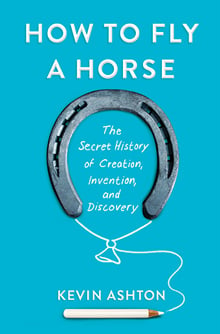Debunking the Genius Myth
Tech innovator and entrepreneur Kevin Ashton rejects the popular notion that there are geniuses among us who do great things the rest of us can never hope to achieve. “This divisive classification scheme of genius at the top is the kind of thing you need to call bullshit on,” he says.

of Creation, Invention, and Discovery
By Kevin Ashton
cofounder of the MIT Auto-ID Center
Doubleday, 2015, $29.95
In his new book, How to Fly a Horse: The Secret History of Creation, Invention, and Discovery, Ashton sets out to debunk what he calls the “creativity myth”—that creative brilliance is the domain of a very few gifted people. “There is really no such thing as a genius—or, to be very specific, there is absolutely no evidence to support the modern sense of the word, which originated in the late 19th century and literally means ‘exceptional hereditary general intelligence that can be measured and used to predict future greatness,’” he says. “That term, by the way, was intended only for white men of European descent.”
How to Fly a Horse encourages readers to believe in the power of their own innate creativity, to work doggedly toward a goal and not be put off by fear of failure. “Trying to know the future before deciding whether to try something is a great way to get nothing done,” Ashton says.
Ashton recounts stories of people whose persistence led to amazing accomplishments. For instance, a botany-loving slave boy named Edmond, on the Indian Ocean island now called Réunion, figured out how to pollinate vanilla orchids, thus setting the vanilla industry in motion. James Dyson, another example, is known as the inventor of a cyclonic vacuum cleaner; he made 5,126 prototypes before hitting on the successful design.
Ashton says he used to buy into the creativity myth himself. After graduating from University College London, he was hired as a brand manager at Procter & Gamble. There, he did pioneering work using radio frequency identification (RFID) chips and sensor-based technology to help keep the shelves stocked with a popular lipstick; to describe the process, he came up with the now-ubiquitous term “the Internet of things.”
Despite his success, Ashton didn’t think his mundane problem-solving methods—hard work and trial and error—were the sort used by people responsible for major discoveries. But his attitude changed when MIT invited him to cofound its Auto-ID Center in 1999 to help foster research in RFID technology. (Ashton stayed until 2003, and during his time at MIT he led efforts that raised $25 million in sponsorship for the center.)
“I went to MIT believing in the myth of innovation,” he says. “I wasn’t having these magical ideas in my sleep but was solving problems gradually, making mistakes along the way.” At MIT, he saw that people he had presumed were geniuses had in fact earned their success the same way he had. “People [at MIT] do extraordinary things that are marvelous to behold, but they do so using recognizable processes,” he says. “It was very validating for me that my experience of creating things was exactly the same as professors and Nobel Prize winners.”
Recent Books From the MIT Community
Island on Fire: The Extraordinary Story of a Forgotten Volcano That Changed the World
By Alexandra Witze ’92 and Jeff Kanipe
Pegasus Books, 2015, $26.95
Cheap and Clean: How Americans Think About Energy in the Age of Global Warming
By Stephen Ansolabehere, former associate professor of political science, and David M. Konisky
MIT Press, 2014, $27.95
Ultrawideband Phased Array Antenna Technology for Sensing and Communications Systems
By Alan J. Fenn, RF Technology Group at MIT Lincoln Laboratory, and Peter T. Hurst ’85, Advanced Capabilities and Systems Group at Lincoln Laboratory
MIT Press, 2015, $75
The Coming Swarm: DDOS Actions, Hacktivism, and Civil Disobedience on the Internet
By Molly Sauter, SM ’13
Bloomsbury Academic, 2014, $19.95
The Outskirts of Hope: A Memoir of the 1960s Deep South
By Jo Ivester ’77
She Writes Press, 2015, $16.95
How to Build a Billion Dollar App
By George Berkowski ’00
Lttle, Brown Book Group, 2015, $24.95
Indians in Kenya: The Politics of Diaspora
By Sana Aiyar, assistant professor of history
Harvard University Press, 2015, $49.95
Bold: How to Go Big, Create Wealth, and Impact the World
By Peter H. Diamandis ’83, SM ’88, and Steven Kotler
Simon & Schuster, 2015, $28
Please submit titles of books and papers published in 2014 and 2015 to be considered for this column.
Contact MIT News
E-mail: mitnews@technologyreview.com
Write: MIT News, One Main Street,13th Floor, Cambridge, MA 02142
Keep Reading
Most Popular
Large language models can do jaw-dropping things. But nobody knows exactly why.
And that's a problem. Figuring it out is one of the biggest scientific puzzles of our time and a crucial step towards controlling more powerful future models.
The problem with plug-in hybrids? Their drivers.
Plug-in hybrids are often sold as a transition to EVs, but new data from Europe shows we’re still underestimating the emissions they produce.
Google DeepMind’s new generative model makes Super Mario–like games from scratch
Genie learns how to control games by watching hours and hours of video. It could help train next-gen robots too.
How scientists traced a mysterious covid case back to six toilets
When wastewater surveillance turns into a hunt for a single infected individual, the ethics get tricky.
Stay connected
Get the latest updates from
MIT Technology Review
Discover special offers, top stories, upcoming events, and more.